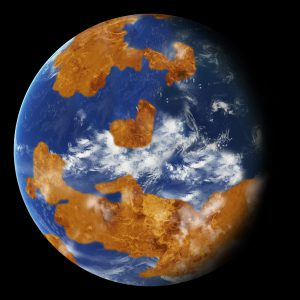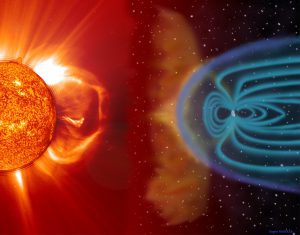Venus, Where did the water go?
By Danielle Wuchner, Rachel Cooper and Jordan Michelson

Figure 1: Photo of Earth taken from outer space. https://www.nasa.gov/feature/goddard/2016/nasa-climate-modeling-suggests-venus-may-have-been-habitable
What Caused the loss of Liquid Oceans on Venus?
As we know, water is one of the fundamental elements required for life as we know it. Therefore, water on any planet can lead to possible life and organisms that could exist in any given environment. It has been hypothesized that the surface of Venus once contained water. Due to the planets current high surface temperatures, and extreme atmosphere, this hypothesis seems highly unlikely. However, there are several factors which have contributed to the loss of liquid water on Venus, leaving behind and the harsh conditions which are presently there. We can understand what happened through the differences between Earth and Venus and asking why Earth is able to successfully retain water while Venus cannot. Solar winds are constantly released from the Sun and create a tremendous burden on Venus and its atmosphere leading to another possible cause of water depletion. Acquiring knowledge on Venus has been gathered from either radar, satellites or spectrophotometers. [25] However, we can only gain so much from these methods, being able to send rovers or other instruments to the surface of Venus would greatly improve our understanding of it as a planet. With these findings and a better understanding of how Venus has evolved, we can start to answer the question of “Where and why has it’s water supply disappeared?”
Water is essential for all life and we can learn a lot about life from studying water. Organisms that have learned and adapted to survive in even the harshest of climates require water for continued survival. Earth and Venus both lie in the Sun’s habitable zone where, if all conditions were favourable, life would be able to survive. Why then is Venus so vastly different from our own planet? There are several reasons why Earth can keep its liquid water, whereas Venus does not have that same ability.
Difference Between Earth and Venus
Earth’s Atmosphere
Earth has a very different chemical makeup, and these differences are why water can stay in liquid form on the surface of Earth. The Earth’s atmosphere consists of 78% nitrogen, 21% oxygen, 0.93% argon, and 0.04% carbon dioxide, with trace amounts of other elements.[1] This is important because nitrogen is a non-reactive gas and that is the majority of the Earth’s atmosphere. The small amount of carbon dioxide also keeps the temperature on Earth within the habitable zone. When Earth rotates, it won’t always be facing the Sun, therefore it needs a way to retain the heat it receives from the Sun. The CO2 traps some of that heat and keeps the Earth warm enough to sustain life. Another essential element that the Earth has is oxygen. We know that oxygen supports life, however, when it is struck by UV light, it creates a compound known as ozone.[2] Oxygen is a very reactive element, and when it reacts with this UV light, it converts that harmful form of light into heat.[3] This reaction, therefore, helps Earth maintain a stable temperature.[4]
Venus’ Atmospheric properties
As Venus is closer to the Sun than Earth is, Venus has the potential to be hotter. Venus has been recorded as reaching surface temperatures of 880 degrees Fahrenheit, which can melt lead. This is, in part, due to the closer proximity of the Sun, but a large part of that high surface

Figure 2: An image showing the atmospheric composition of Venus. http://venus.aeronomie.be/en/venus/clouds.htm
temperature is because of runaway greenhouse gas effect. The atmosphere or cloud layer, covering Venus consists mostly of carbon dioxide and sulphuric acid droplets. These droplets were studied and identified using spectroscopy to discern the composition of the atmosphere. They were also later used toareeasure in situ, or on site, by the Russian space probe Venera 4 to determine the amounts of each component.[5] There is roughly 96% carbon dioxide and 0.15% sulphur dioxide, which combines with water vapours and forms sulphuric acid.[6] This is important as both the sulphuric acid and carbon dioxide do different, but crucial things, to the climate on Venus. The sulphuric acid in the clouds causes the atmosphere to be opaque and reflect or absorb the incoming light, depending on its wavelength. Any light above 400nm does not reach the surface of Venus.[7] CO2 then traps all that light, specifically infrared light, and that causes the surface temperature to increase. Since water boils at 100 degrees Celsius under normal pressure conditions, a high surface temperature would create a huge increase in water evaporation.
Earth’s Core and Surface
Earth is covered by roughly 71 percent liquid water. Water is essential for supporting life and combined with an average temperature of approximately 15 degrees Celsius.[8] These conditions are near perfect to foster life here on Earth. The Earth’s core is composed of iron and nickel. The inner core is solid, whereas the outer core is liquid. The liquid flows and creates currents and convection; this convection is what creates Earth’s magnetic field.[9] The magnetic field protects Earth from the harmful solar winds and allows Earth to retain water because the Earth has plate tectonics and a protective magnetic field that prevents hydrogen from being stripped from the atmosphere. Also, because it has volcanic activity on the ridges of the tectonic plates, it is easier for Earth to retain water.[10]
Venus’ Core and Surface
If we look at Venus through a telescope, we see a bright reflective surface, covered in clouds. This led many early astronomers to believe that Venus is a fertile jungle planet that could support life. This could not be further from the truth. The surface of Venus is a volcanic landscape with hellish temperatures and unbearable conditions. The pressure alone is roughly the same as it would be if we swam 1 mile below the ocean’s surface here on Earth.[11] Since Venus lacks water in a liquid state, it

Figure 3: A radar image of Venus’ topography, showing one of the many volcanic features on Venus, a cluster of volcanic domes. https://airandspace.si.edu/exhibitions/exploring-the-planets/online/solar-system/venus/volcanism.cfm
doesn’t have the same tectonic activity that Earth does. This means that the core can spew out large amounts of molten elements and create large basins. We know this from some of the radar images we have taken from satellites sent to Venus.[12
Venus is not currently volcanically active, at least from what we have observed from space. The majority of its volcanic activity occurred 200-500 million years ago and resurfaced the planet.[13] All of this is important to note because there is evidence that water could have been present in the liquid state on Venus at some point. Granite was found on the surface of Venus and can only be formed from basalt and water and mixed through plate tectonics, and then are sent to the surface by volcanic activity.[14] If there is indeed granite on the surface, that confirms there was once liquid water on Venus, and some combination of factors removed that liquid water from the surface.
This period 200-500 million years ago could also have impacted the number of gasses in the atmosphere. By having all this volcanic activity, it could add more water vapour into the atmosphere and further push the greenhouse effect.[15] Adding the equivalent of the Earth’s ocean to the atmosphere would cause a drastic change in temperature. Venus’ core has roughly the same composition of Earth’s core. However, due to the slow rotation of Venus, and the effect of its retrograde motion, it does not produce a strong magnetic field. This means that Venus is more susceptible to water loss through the Sun’s powerful rays.
Effects of Solar Winds
Solar Winds
The effects of solar winds and how they influence Venus can help us to understand the possible history of Venus having water and ways that it could have been diminished. Solar winds are caused by the release of charged particles which are constructed of electrons, protons, and alpha particles containing a high kinetic energy.[16] This plasma source is released from the Sun’s upper atmosphere known as the corona. The corona is an aura or crown-shaped plasma energy surrounding the Sun that extends for millions of Kilometers. The plasma temperature reaches heats of 1.1 million degrees Celsius. The Sun’s gravitational force is not strong enough to hold such fast-moving particles which result in the corona.[17] These winds are accelerated through space at supersonic speeds of nearly a million miles per hour. Earth and planets like Jupiter have protective magnetosphere shielding them from the harsh effects of solar winds.[18]
Earth’s Magnetosphere

Figure 4: Image showing the Earth’s Magnetosphere deflecting solar winds emitted from the Sun. https://www.losangeles.af.mil/News/Photos/igphoto/2000043608
A magnetosphere is a large volume of space around an astronomical object that creates a protective shield controlled by the planet’s magnetic field.[19] Earth’s magnetic field creates a powerful magnetosphere which is the key to preserving the atmosphere and being able to sustain water and life. As displayed in Figure 4, Earth’s magnetosphere creates a spherical bubble on the Sunward side and tails out towards the back on the Sunless side. Without this protective shield, solar winds would continuously be putting an enormous stress on the Earth’s atmosphere and ozone. The depletion of the atmosphere could result in ozone holes which would cause cosmic radiation to be released, vulnerability to the Sun’s emissions, celestial weather events, and extreme climate changes.[20] All these possible consequences for the Earth’s depletion of a magnetosphere could be possible past occurrences already displayed by Venus and could explain why it’s water supply has ceased to exist.
Effects of solar winds on Venus
Venus produces a magnetic field through the interaction between its ionosphere and solar winds, the ionosphere being “the layer of the Venus’ atmosphere that is ionized by solar and cosmic radiation”.[21] The magnetic field of Venus is significantly smaller than Earth’s, providing it with a much smaller magnetosphere. This leaves Venus vulnerable to the harsh consequences of solar plasma.[22] Hydrogen could have been stripped from Venus because of the effect of the solar wind on the upper atmosphere.[23] These findings help us to answer why Venus cannot retain water.
Exploration of Venus
Past Explorations on Venus
Since 1961, there have been 43 attempts to send different kinds of explorations (flyby, lander, atmospheric, orbiter, or a combination) to Venus. Of these 43 missions, 26 are considered at least partially successful.[24][25]
8 missions were orbiters or included orbiting, which means they were sent up into space to orbit and study Venus. All 8 missions had various degrees of success but were ultimately considered successful attempts.
21 of the missions were or had a flyby mission component. Flyby missions involve sending the probe to move past the planet, close enough it can record scientific data.[26] 13 of these missions were considered successful while 8 failed, either because of a launch failure or loss of contact with the probe. Loss of contact with the probe seemed to happen after it had flown by Venus and collected data, although the data was never able to be recovered.[27]
20 of the missions were landers or involved landing on Venus. Lander missions involve the probe slowly descending onto the planet in order to survey the surface of the planet. Of the 19 missions, 10 of them were considered full or partial successes. Most of the failed missions were due to launch failures, while only a couple lost contact out in space.[28]
There were two missions that involved atmospheric probes in order to study Venus’ atmosphere. Both were considered successful in their target to acquire data about Venus’ atmosphere.[29]
There is currently one space mission in progress regarding Venus. In 2010, Japanese scientists launched the Akatsuki, an atmospheric probe that was supposed to orbit Venus. Unfortunately, it didn’t enter Venus’ orbit properly, so the scientists had to let it orbit around the Sun. They later made the decision to attempt to push it into Venus’ orbit after its loop around the Sun. In December of 2015, they succeeded in using the Akatsuki’s thrusters to get it into orbit around Venus.[30]
Future Work
Until we can see and study the surface of Venus properly, not a whole lot more new and innovative scholarship can really be done regarding the planet. That being said, there are currently two spacecrafts that have just launched recently and will be, at least in part, studying Venus. The first, called the Parker Solar Probe, is going to be using Venus’ gravitational pull to get closer to the Sun so it can orbit around the Sun. However, while it is using Venus for the gravitational pull, it will be doing seven flybys, getting images of Venus.[35] The probe was launched on August 12 of 2018 and is so far working and in communication with NASA. The second mission that just launched in October of 2018 is called the BepiColombo and is a joint mission between the ESA and the JAXA. The plan was to send two satellites up to study Mercury, doing two flybys for imaging of Venus on the way to Mercury.[36]
The ISRO has proposed sending an orbiter to Venus and is in the process of figuring out science payload. They are hopeful of a launch to image and study the atmosphere and surface of Venus in the early 2020s.[37]
The last proposed mission to Venus comes from Russia with NASA thinking about joining them in the project. With a probe called the Venera-D, they plan to use radar imaging to study Venus. There is also plans and proposals in the works to send a lander down to attempt another study of Venus’ surface with the probe. Russia is currently proposing a 2026 launch date for the probe and lander.[38]
In Conclusion
Through looking at the similarities between Earth and Venus we were able to learn more about these two respective planets. We can conclude that Venus lost its liquid oceans on its surface through the effects of solar winds and a runaway greenhouse effect. This runaway greenhouse effect caused an increase in temperature on the surface of Venus and, as more and more water vapour was added to the atmosphere, it only added to this effect. Once the water vapour reached the atmosphere, the solar winds stripped a majority of the hydrogen away. Now we see that Venus is a very hot, hostile environment that has very little water present, even in the atmosphere. In order to fully solidify our understanding, the future missions to explore the surface of Venus can help us to gain more evidence of where the water went as well as develop our understanding of Venus as a whole. As with anything the closer you can get, the more information you can learn. That’s why the rover missions and plans are so exciting, they can open up a whole new understanding of Venus and why it is so different from Earth today.
References
[1] Space.com, Earth’s Atmosphere: Composition, Climate & Weather https://www.space.com/17683-earth-atmosphere.html (Accessed 2 November 2018) [2] NASA, For educators: Ozone https://www.nasa.gov/audience/foreducators/postsecondary/features/F_Ozone.html (Accessed 2 November 2018) [3] Britannica, Photochemical reaction, https://www.britannica.com/science/photochemical-reaction (Accessed 2 November 2018) [4] NASA, Venus: In depth, https://solarsystem.nasa.gov/planets/venus/in-depth (Accessed 1 November 2018) [5] SOIR, Venus: Venus’ Atmosphere, http://venus.aeronomie.be/en/venus/atmosphere.htm (Accessed 2 November 2018) [6] SOIR, Venus: Venus’ Atmosphere, http://venus.aeronomie.be/en/venus/atmosphere.htm (Accessed 2 November 2018) [7] SOIR, Venus: Venus’ Atmosphere, http://venus.aeronomie.be/en/venus/atmosphere.htm (Accessed 2 November 2018) [8] Space.com, Planet Earth: Facts About Its Orbit, Atmosphere & Size, https://www.space.com/54-earth-history-composition-and-atmosphere.html (Accessed 2 November 2018) [9] Space.com, Planet Earth: Facts About Its Orbit, Atmosphere & Size,https://www.space.com/54-earth-history-composition-and-atmosphere.html (Accessed 4 November 2018) [10] Space.com, Planet Earth: Facts About Its Orbit, Atmosphere & Size, https://www.space.com/54-earth-history-composition-and-atmosphere.html (Accessed 4 November 2018) [11] NASA, Venus: In depth, https://solarsystem.nasa.gov/planets/venus/in-depth (Accessed 4 November 2018) [12] Smithsonian National Air and Space Museum, Venus: Volcanism, https://airandspace.si.edu/exhibitions/exploring-the-planets/online/solar-system/venus/volcanism.cfm (Accessed 3 November 2018) [13] Space.com, Volcanoes on Venus Erupted Recently, New Study Suggests, https://www.space.com/34420-venus-volcanos-erupted-recently-hotspot-study-suggests.html (Accessed 3 November 2018) [14] Universe Today, Nancy Atkinson: New map hints at Venus’ wet volcanic past, https://www.universetoday.com/34758/new-map-hints-at-venus-wet-volcanic-past/ (Accessed 5 November 2018) [15] SOIR, Venus: Water and Greenhouse effect, http://venus.aeronomie.be/en/venus/water-greenhouse.htm (Accessed 5 November 2018) [16] Space.com. What is Solar Wind, https://www.space.com/22215-solar-wind.html (Accessed 2 November 2018) [17] Space.com. What is Solar Wind, https://www.space.com/22215-solar-wind.html (Accessed 6 November 2018) [18] Astrobiology. Venus: Solar Winds Explode on Venus, https://www.astrobio.net/also-in-news/solar-wind-explodes-on-venus/ (Accessed 2 November 2018) [19] Pluto Space. Magnetosphere, http://pluto.space.swri.edu/image/glossary/magnetosphere.html (Accessed 7 November 2018) [20] Apex Magnets. What Would Happen if Earth’s Magnetic Field Disappeared, https://www.apexmagnets.com/news-how-tos/what-would-happen-if-earths-magnetic-field-disappeared/ (Accessed 6 November 2018) [21] Stanford, Tracking Solar Flares, http://solar-center.stanford.edu/SID/activities/ionosphere.html (Accessed 6 November 2018) [22] Universe Today. Venus Compared to Earth, https://www.universetoday.com/22551/venus-compared-to-earth/ (Accessed 2 November 2018) [23] Space.com, Science & Astronomy: Where Venus’ Water Went, https://www.space.com/6273-venus-water.html (Accessed 5 November 2018) [24] NASA, Chronology of Venus Exploration, https://nssdc.gsfc.nasa.gov/planetary/chronology_venus.html (Accessed 1 November 2018) [25] The Planetary Society, Missions to Venus and Mercury,http://www.planetary.org/explore/space-topics/space-missions/missions-to-venus-mercury.html#planetc (Accessed 2 November 2018) [26] Dictionary.com, Flyby, https://www.dictionary.com/browse/flyby (Accessed 2 November 2018) [27] NASA, Chronology of Venus Exploration, https://nssdc.gsfc.nasa.gov/planetary/chronology_venus.htm (Accessed 2 November 2018) [28] NASA, Chronology of Venus Exploration,https://nssdc.gsfc.nasa.gov/planetary/chronology_venus.html (Accessed 2 November 2018)29] NASA, Chronology of Venus Exploration, https://nssdc.gsfc.nasa.gov/planetary/chronology_venus.html (Accessed 2 November 2018)
[30] The Japan Times, Japanese probe fires thrusters in second bid to enter Venus orbit, https://www.japantimes.co.jp/news/2015/12/07/national/science-health/jaxa-plans-fire-probes-thrusters-second-attempt-venus-orbit/#.W-SDSpNKhqM (Accessed 2 November 2018) [31] NASA, A Clockwork Rover for Venus, https://www.nasa.gov/feature/jpl/a-clockwork-rover-for-venus (Accessed 2 November 2018) [32] NASA, A Clockwork Rover for Venus, https://www.nasa.gov/feature/jpl/a-clockwork-rover-for-venus (Accessed 2 November 2018) [33] NASA, A Clockwork Rover for Venus, https://www.nasa.gov/feature/jpl/a-clockwork-rover-for-venus (Accessed 4 November 2018) [34] NASA, A Clockwork Rover for Venus, https://www.nasa.gov/feature/jpl/a-clockwork-rover-for-venus (Accessed 4 November 2018) [35] NASA, Parker Solar Probe, http://parkersolarprobe.jhuapl.edu/index.php#spacecraf (Accessed 4 November 2018) [36] ESA, BepiColombo Factsheet, http://www.esa.int/Our_Activities/Space_Science/BepiColombo/BepiColombo_factsheet (Accessed 4 November 2018) [37] ISRO, Announcement of Opportunity (AO) for Space Based Experiments to Study Venus, https://www.isro.gov.in/announcement-of-opportunity-ao-space-based-experiments-to-study-venus (Accessed 4 November 2018) [38] Space.com, Russia, US Mulling Joint Mission to Venus, https://www.space.com/35333-russia-nasa-venus-mission-venera-d.htm (Accessed 4 November 2018)Background Headings
Heading 1: Venus Landscape https://www.jpl.nasa.gov/spaceimages/details.php?id=PIA00106
Heading 2: Comparison of Earth to Venus https://pixabay.com/en/venus-earth-size-comparison-planet-11588/
Heading 3: Diagram of solar wind patterns https://en.m.wikipedia.org/wiki/File:Structure_of_the_magnetosphere-en.svg
Heading 4: Rover Landscape https://mars.nasa.gov/resources/21378/nasas-mars-2020-rover-artists-concept-3/